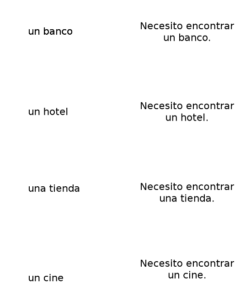[youtube id=”YpfE9N-V9Ig” align=”center” mode=”normal” maxwidth=”700″]
Create Your Own Interaction Pattern
Overview:
6 Easy Steps
Step 1 – Find a phrase
Step 2 – Comprehend the phrase
Step 3 – Choose a pattern type
Step 4 – Create variations
Step 5 – Set up an interaction
Step 6 – Engage the interaction
Simplified Steps:
Step 1 – Find a phrase
Necesito encontrar un banco.
Step 2 – Comprehend the phrase
Necesito encontrar un banco. I need to find a bank.
Comprehending the phrase includes 2 things – recognizing it in the new language and understanding it’s meaning. The above example gives you everything you need to recognize and understand the phrase.
Step 3 – Choose a pattern type.
- Substitution – Substitute part of the phrase for something else
- Question / Answer – Pose a question and answer it
- Transformation – Manipulate part of the phrase into a different form
- Combination – Combine two smaller phrases to make one big one
- Translation – Translate from English into the new language
Step 4 – Create variations
Variations can be created by reproducing the phrase using small changes. The core phrase remains the same while the variations provide just enough change to yield different sentences. This provides your mind with enough similarity to become familiar with the phrase and enough novelty to stay engaged with it while you practice.
Step 5 – Set up an interaction
Prompt: Response:
un banco Necesito encontrar un banco.
un hotel Necesito encontrar un hotel.
una tienda Necesito encontrar una tienda.
un cine Necesito encontrar un cine.
This is the MOST IMPORTANT STEP in the whole strategy. Many study materials are filled with patterns, but there’s never a way given for you to practice that pattern. If you’re not actively using the patterns, they will never become second nature.
Interactions are the best way I’ve found to use patterns. There are 2 parts to an interaction – a prompt followed by a response. In the above examples the prompt is the place (banco) and the response is entire phrase (Necesito encontrar un banco). The prompt is used to draw the response from you.
Essentially this is what conversation is. Someone says something to you (a prompt) then you reply to what they said (a response).
Even though the interactions we are making here are not conversations, they keep the mind engaged the same way a conversation would. This helps us practice getting used to phrases without using mindless repetition which has very little impact on learning another language.
Step 6 – Engage the interaction
Read prompt and respond from memory: Check the answer:
una tienda Necesito encontrar una tienda.
The idea here is to first read only the prompt and respond out loud from memory. After you respond to the prompt, check to see if your response is right.

If you are using a notebook, write all the prompts on the right side of the page and all the responses on the left. Cover up all the responses and go down the list, only checking your answer after you try responding from memory.

If you are using flashcards, write all the prompts on one side and all the responses on the other. Mix up the cards with the prompts facing up. Look at the prompt and respond from memory. Check your answer by flipping the card over.
My recommendation is to make 10-20 interaction patterns for one phrase. It may sound tedious, but it is going to help your mind become familiar with responding to and engaging that phrase in the new language.

Your article helped me a lot, is there any more related content? Thanks! https://accounts.binance.com/pt-BR/register-person?ref=V3MG69RO
Can you be more specific about the content of your article? After reading it, I still have some doubts. Hope you can help me. https://accounts.binance.com/uk-UA/register?ref=V2H9AFPY
Can you be more specific about the content of your article? After reading it, I still have some doubts. Hope you can help me.
Can you be more specific about the content of your article? After reading it, I still have some doubts. Hope you can help me.
Thanks for sharing. I read many of your blog posts, cool, your blog is very good.
I don’t think the title of your article matches the content lol. Just kidding, mainly because I had some doubts after reading the article.
Thanks for sharing. I read many of your blog posts, cool, your blog is very good.
Thank you very much for sharing, I learned a lot from your article. Very cool. Thanks.